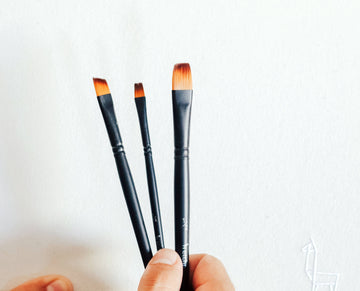Quality paintbrushes are a big part of any artist’s budget. We’ll show you how to protect your investment with regular care and cleaning and make your brushes last for years.

This brush is covered in paint, and if I put it away like this, the paint will dry, increasing the risk of the bristles tearing. Watercolour is the easiest to clean from a brush because it thins in plain water so easily and never has a gummy consistency. However, there are some things to keep in mind when rinsing your brush.
Tip 1: Keeping the Handle Dry

The metal piece on the end of your brush where the bristles come out is called the ferrule. If water collects in here long enough, it may ruin the brush. Stagnant moisture at room temperature never has a healthy outcome. If your brush has a wooden handle, water sticking in the ferrule will be absorbed inside and warp the wood. Wood expands in water. If the handle’s wood expands, the handle’s paint won’t, so the paint will fall off in chips. How do you prevent this? Keep the handle out of the water as much as possible. See in the above picture how I scrub the bristles along the side of the water basin and not the bottom. The handle stays a lot drier than it would otherwise.
Tip 2: Washing Quickly

If there’s a lot of paint in your brush, it might not work to only scrub it along the smooth side of your water basin. The brush shown here is one of my very thirstiest, and I have to clean it by rubbing it on the bottom of the bucket. That seems to be a deeper cleaning method.
It’s not great for the handle, but I still do it once in a while to get intense pigments out of the ferrule. Don’t be too rough. As long as you make it quick, your brush won’t be harmed.
Tip 3: The Paper Towel Test

Many times, a brush will look cleaner than it truly is. Those sneaky ferrules can and will trap paint! To test the cleanliness of your brush, dry it off on a paper towel and see what colour is the water. If the water is tinted, then the brush is still dirty. The paper towel drew pigment from inside the brush, so you’ll need to rewash it.

Now that I rewashed the brush, the water on the paper towel is clear! Frequently I’ll try to get the brush clean without plunging it in all the way to the bottom, but if it’s not coming clean, I put it all the way in the water for a more aggressive clean.
Tip 4: Deep Cleaning
Your brushes will benefit from a spring cleaning just like your house! One of my favourite things to use for my brushes is The Masters’ Brush Cleaner and Preserver, which you can find affordably at Jackson’s Art.
This is a soap and conditioner all in one and will clean any paint off of any brush! The bubbles go deep into the brush and lift away particles of old paint buildup, leaving your brush like new! Clean a brush this way so it will hold more paint and will be once again well-shaped.

To use this soap, wet the brush, then scrub it in the soap until the lather goes deep into the bristles. You’ll notice the soap becomes tinted with old paint as the brush returns to its original colour. It’s so satisfying!
Then rinse the brush in your kitchen tap, and repeat the lathering cycle if there’s still more to clean. In my experience, brushes that have been used for gouache need the most cleaning.
Gouache is hard on brushes, so this brush cleaner will significantly improve their usefulness and overall lifespan. To keep a gouache brush in ideal condition, deep clean it every 3-5 paintings.
Supplies and gear are a valuable investment that, when properly cared for, will noticeably enhance your painting experience. In time, you’ll find caring for your supplies is fun because you’re taking ownership and responsibility for every single aspect of your art, from the creative process to the logistics of your studio.
Have a great time painting with your clean brushes! For more helpful painting tips, subscribe to our Etchr email newsletter!


